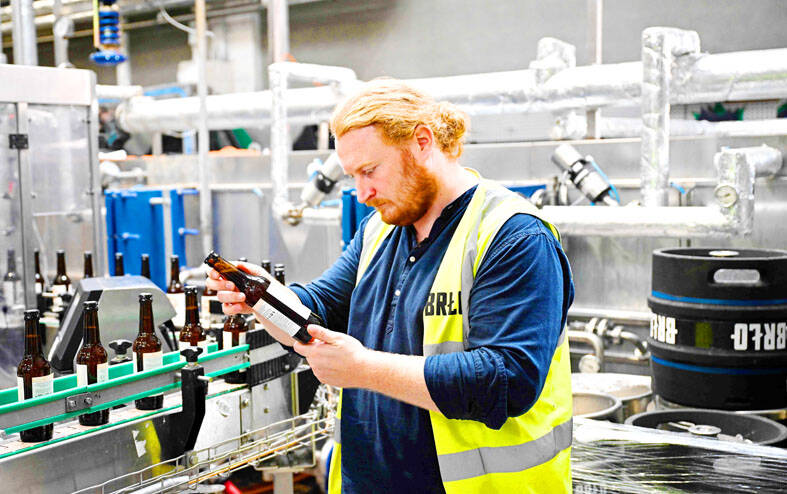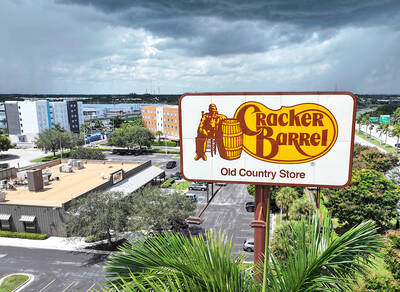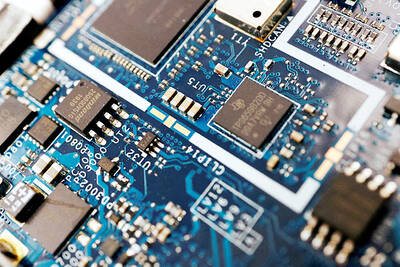All the fun of the Oktoberfest, without the hangover: Germans are swapping traditional beer for non-alcoholic brews, driven by health concerns and the increasing quality of booze-free options. Beers containing less than 0.5 percent alcohol — the legal limit to be classed as non-alcoholic — are no longer an uncommon sight in the country’s famous beer gardens.
“I like the taste of beer, but I don’t find it reasonable to always drink it with alcohol,” Kathrin Achatz, 40, said at the BRLO beer garden in Berlin.
The volume of non-alcoholic beer produced in Germany has almost doubled over the past 10 years, reaching 670 million liters last year, federal statistics office Destatis said.

Photo: AFP
In a survey last yearby the Allensbach Institute, non-alcoholic beer represented about 7 percent of total beer purchases.
“We are seeing a strong increase in demand,” said Holger Eichele, secretary-general of the German Brewers Federation, which represents the interests of the brewing industry.
BRLO, whose beer garden is in Berlin’s central Kreuzberg district, but which produces most of its beer from a brewery further out in Spandau, was an early adopter.
The brewery, which prides itself on producing all its beer in Berlin, launched its “Naked” non-alcoholic range in 2017.
Since then, sales have grown sharply, jumping 60 percent last year from 2021.
“Since day one, this beer has been appreciated by our customers,” said Michael Lembke, one of the brewery’s managers.
Inside the brewery, about 15 workers clad in heavy boots assemble orders in a maze of pipes and conveyor belts.
About 160 hectoliters of Naked beer are produced here every month.
Launched in the 1970s, non-alcoholic beer was initially designed for a niche market: motorists, pregnant women or recovering alcoholics.
But in the past few years, the booze-free beverage has broken into the mainstream. The number of brands on offer has doubled since 2010 to reach more than 700, the German Brewers Federation said.
This is partly down to improved brewing techniques that have led to an increase in quality — something that had previously held non-alcoholic beer back from breaking into the mass market.
At BLRO, the drink is made with a special yeast that prevents alcohol from being created during fermentation, without compromising on flavor. The beer is fermented for a week in the brewery’s huge gray vats.
The boom in non-alcoholic beer in Germany has also been partly down to health trends and a growing awareness of the harmful effects of alcohol.
“There is a growing awareness of health imperatives in the population,” Eichele said.
“Sometimes you want to have a drink, but you don’t want to feel the effects of alcohol,” said Max Thomas, a 44-year-old Briton based in Berlin.
Although Germans are among the biggest consumers of alcohol in the world, at 10 liters of pure alcohol per inhabitant per year, consumption is falling, especially among young people.
A study by the German Federal Centre for Health Education found that 8.7 percent of young people aged 12 to 17 drink alcohol at least once a week. In 2011, that figure was about 14 percent, and in 1979 it was 25 percent.
The average German consumed 87.2 liters of beer last year, compared with nearly 100 liters in 2013, according to Destatis.
The industry is therefore expecting non-alcoholic beers to continue to grow, with the federation predicting they would eventually account for 20 percent of the market.
“It will not completely replace classic beer, but it has enormous potential,” Eichele said.

On Tuesday, US President Donald Trump weighed in on a pressing national issue: The rebranding of a restaurant chain. Last week, Cracker Barrel, a Tennessee company whose nationwide locations lean heavily on a cozy, old-timey aesthetic — “rocking chairs on the porch, a warm fire in the hearth, peg games on the table” — announced it was updating its logo. Uncle Herschel, the man who once appeared next to the letters with a barrel, was gone. It sparked ire on the right, with Donald Trump Jr leading a charge against the rebranding: “WTF is wrong with Cracker Barrel?!” Later, Trump Sr weighed

SinoPac Financial Holdings Co (永豐金控) is weighing whether to add a life insurance business to its portfolio, but would tread cautiously after completing three acquisitions in quick succession, president Stanley Chu (朱士廷) said yesterday. “We are carefully considering whether life insurance should play a role in SinoPac’s business map,” Chu told reporters ahead of an earnings conference. “Our priority is to ensure the success of the deals we have already made, even though we are tracking some possible targets.” Local media have reported that Mercuries Life Insurance Co (三商美邦人壽), which is seeking buyers amid financial strains, has invited three financial

Artificial intelligence (AI) chip designer Cambricon Technologies Corp (寒武紀科技) plunged almost 9 percent after warning investors about a doubling in its share price over just a month, a record gain that helped fuel a US$1 trillion Chinese market rally. Cambricon triggered the selloff with a Thursday filing in which it dispelled talk about nonexistent products in the pipeline, reminded investors it labors under US sanctions, and stressed the difficulties of ascending the technology ladder. The Shanghai-listed company’s stock dived by the most since April in early yesterday trading, while the market stood largely unchanged. The litany of warnings underscores growing scrutiny of

OUTLOOK: Among the six sub-indices, only the stock market confidence sub-index rose due to strong equity performance and expectations of a US Federal Reserve rate cut Consumer confidence weakened further this month, sliding to its lowest level in two-and-a-half years as households grew increasingly uneasy about the economic outlook, job security and big-ticket spending, a survey by the National Central University showed yesterday. The consumer confidence index fell 1.07 points from last month to 63.31, the weakest number since May 2023, said the university’s Research Center for Taiwan Economic Development (RCTED), which conducts the monthly poll. “Although the Directorate-General of Budget, Accounting and Statistics recently increased Taiwan’s GDP growth forecast for this year to 4.45 percent, consumer sentiment tells a different story,” RCTED director Dachrahn Wu